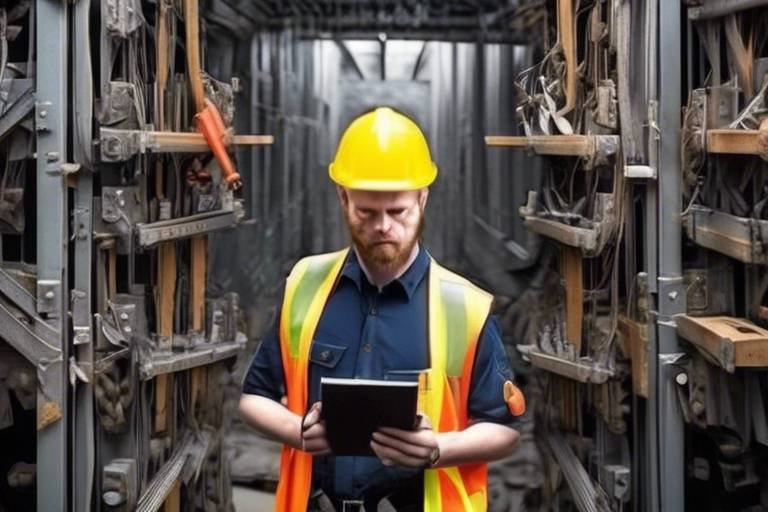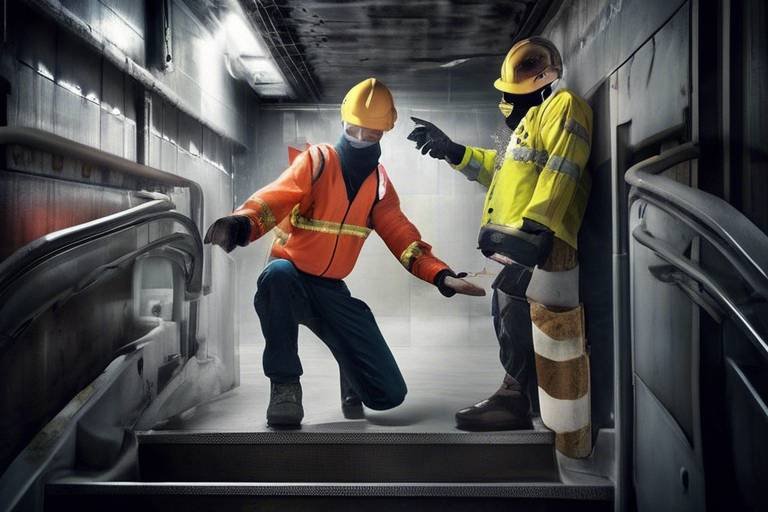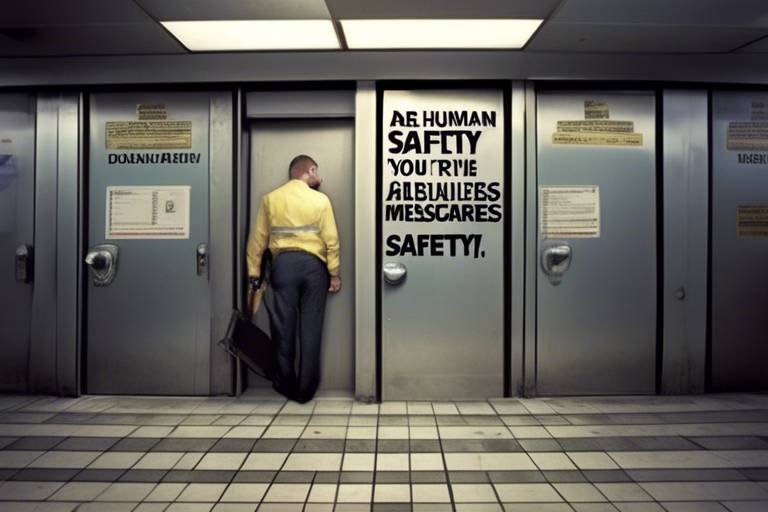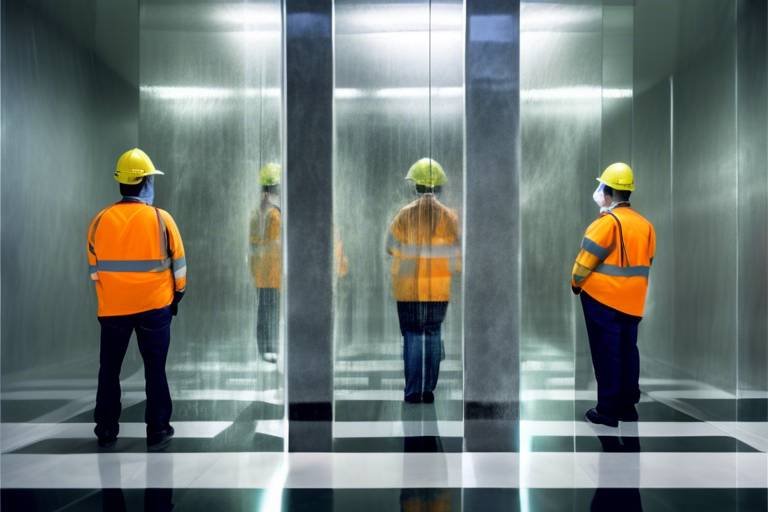Can an In-depth Understanding of Human Behavior Ensure Safety?
In today's world, where the unexpected can occur at any moment, ensuring safety is more critical than ever. But how do we truly safeguard ourselves and others? The answer lies in a profound understanding of human behavior. By delving into the intricacies of how we think, feel, and act, we can develop strategies that not only enhance safety but also foster a culture of awareness and responsibility. Imagine if we could anticipate potential hazards by understanding the psychological triggers that lead to risky behavior. This article explores the intricate relationship between human behavior and safety, delving into psychological insights, risk assessment, and strategies that can enhance safety protocols in various environments.
Understanding how individuals perceive risk is crucial for developing effective safety measures. Risk perception is not just about the actual danger present; it’s also about how people interpret that danger. Factors such as past experiences, cultural influences, and emotional responses play significant roles in shaping our understanding of risk. For instance, if someone has had a negative experience with a particular situation, they are likely to perceive that situation as riskier than someone who has not. Addressing these perceptions can lead to improved safety outcomes. By educating individuals about the real risks involved, we can shift their perceptions and encourage safer behaviors.
Behavioral interventions can significantly enhance safety practices. These interventions focus on modifying behavior through various strategies that leverage human psychology. For example, in workplaces, implementing safety protocols that require regular safety drills can create a habit of safety awareness among employees. Similarly, in public spaces, using visual cues and reminders can prompt individuals to engage in safer actions. The key is to make safety a part of the everyday routine, so it becomes second nature. Here are a few strategies:
- Regular training sessions that emphasize the importance of safety.
- Incentive programs that reward safe behavior.
- Creating a supportive environment where individuals feel comfortable reporting unsafe conditions.
Cognitive biases often lead to poor decision-making regarding safety. Understanding these biases is essential for improving risk assessment and safety behaviors. For instance, anchoring bias can skew perceptions of risk based on initial information. If someone hears that a certain activity is "safe" without any context, they might overlook potential dangers associated with it. On the other hand, optimism bias leads individuals to underestimate risks, believing that "it won't happen to me." Recognizing these biases allows us to tailor safety messages that resonate more effectively with individuals, helping them to make informed decisions.
Anchoring bias can significantly affect how we assess risks. When people are presented with initial information, it can anchor their perceptions and skew their judgment. For instance, if a safety briefing emphasizes a low accident rate without discussing underlying risks, individuals may become complacent. To counteract this, safety communication should provide balanced information that highlights both the benefits and risks associated with certain behaviors.
Optimism bias can lead individuals to underestimate risks, which can be detrimental in safety contexts. Many believe that they are less likely to experience negative outcomes compared to others. To foster a culture of safety awareness, it is crucial to challenge this bias. This can be achieved through storytelling and sharing real-life examples of accidents that occurred due to complacency. By making the risks relatable, individuals can better understand the importance of safety precautions.
Social dynamics play a critical role in shaping safety behaviors. Peer pressure and social norms can either promote or hinder safe practices. For example, if a group of friends dismisses the importance of wearing helmets while biking, others may feel pressured to follow suit, despite knowing the risks involved. Conversely, when safe practices are celebrated within a community, they become the norm. Understanding these social influences can help in designing interventions that leverage positive peer pressure to encourage safer behaviors.
Clear communication is essential for ensuring safety. Without effective messaging, even the best safety protocols can fall flat. When conveying safety information, it’s important to consider the audience's background, knowledge level, and emotional state. Using straightforward language, visual aids, and relatable examples can enhance understanding and compliance. Moreover, emotional appeals can be powerful tools in safety communication. By tapping into emotions, we can motivate individuals to adopt safer behaviors.
Emotional appeals can significantly impact how safety messages are received. When individuals feel a strong emotional connection to a message, they are more likely to internalize it and act on it. For instance, sharing personal stories about the consequences of unsafe behavior can resonate deeply with audiences, prompting them to reflect on their own actions. This emotional engagement is crucial for fostering a culture of safety.
Technology offers innovative ways to enhance safety communication. From mobile apps that provide real-time safety alerts to social media campaigns that raise awareness about specific risks, the possibilities are endless. Utilizing technology not only makes safety information more accessible but also allows for quick dissemination during emergencies. As we continue to embrace technological advancements, integrating these tools into safety protocols will be essential for improving overall safety outcomes.
Training and education are vital components of safety protocols. Ongoing education fosters a safety-conscious culture, ensuring that individuals remain aware of potential risks and the best practices to mitigate them. Regular training sessions, workshops, and refresher courses can reinforce the importance of safety in various environments. The goal is to create an environment where safety is prioritized and ingrained in everyday practices.
Effective training programs are essential for instilling safe practices. A successful program should include hands-on training, real-life scenarios, and assessments to gauge understanding. Moreover, it’s important to tailor training to the specific needs of the audience. For example, safety training for construction workers will differ significantly from that for office employees. By addressing the unique challenges faced by different groups, we can enhance the effectiveness of safety training initiatives.
Evaluating the effectiveness of training programs is crucial. It’s not enough to conduct training; we must assess whether it translates into improved behaviors and outcomes. This can be done through surveys, direct observations, and incident reports. By regularly assessing training outcomes, organizations can identify areas for improvement and ensure that safety remains a top priority.
Q: How can understanding human behavior improve safety protocols?
A: By understanding the psychological factors that influence behavior, we can design safety protocols that are more effective and resonate with individuals on a personal level.
Q: What role do cognitive biases play in safety?
A: Cognitive biases can lead to misjudgments about risks, which can hinder safe practices. Recognizing these biases allows for better communication and training strategies.
Q: How can technology enhance safety communication?
A: Technology allows for real-time updates, accessible information, and innovative communication methods that can significantly improve safety awareness and response.

The Psychology of Risk Perception
Understanding how we perceive risk is like peeling an onion; it has many layers, and each layer reveals something deeper about our instincts and behaviors. Risk perception is not just about the actual danger present but also about how we interpret that danger based on our experiences, emotions, and even societal influences. For instance, consider how two individuals might react differently to the same situation—one might see a potential hazard and take precautions, while the other might dismiss it entirely. This disparity often stems from various factors that shape our perception of risk.
One of the key elements influencing risk perception is personal experience. If someone has previously faced a negative outcome in a similar situation, they are likely to perceive a higher risk. Conversely, a person who has never encountered a problem may underestimate the danger. This phenomenon can lead to a dangerous cycle where individuals ignore potential threats because they have not personally experienced negative consequences. Additionally, media coverage plays a significant role in shaping our perceptions. Events that receive extensive media attention, such as natural disasters or accidents, can create a heightened sense of risk, even if statistically, the likelihood of such events is low.
Another fascinating aspect of risk perception is the influence of cognitive biases. These biases are mental shortcuts that help us process information quickly but can lead to distorted views of reality. For example, the availability heuristic causes people to judge the probability of events based on how easily examples come to mind. If a person frequently hears about plane crashes in the news, they might perceive flying as riskier than driving, despite statistics showing that flying is far safer. Understanding these biases is crucial for developing effective safety protocols, as they can significantly impact how individuals assess risks.
Furthermore, social dynamics also contribute to risk perception. The opinions and behaviors of those around us can greatly influence how we view risks. If a person is surrounded by peers who downplay safety concerns, they may adopt a similar mindset, leading to risky behaviors. On the other hand, a supportive community that emphasizes safety can encourage individuals to be more vigilant and proactive about their well-being. This interplay between individual perception and social influence highlights the importance of fostering a culture of safety that encourages open discussions about risks and promotes collective responsibility.
In summary, the psychology of risk perception is a complex web woven from personal experiences, cognitive biases, and social influences. By understanding these factors, we can better tailor safety measures to address the unique perceptions of different individuals and communities. This approach not only enhances safety outcomes but also fosters a more informed and aware society.
- What is risk perception?
Risk perception refers to an individual's assessment of the dangers associated with a particular situation or event, influenced by personal experiences, cognitive biases, and social factors. - How do cognitive biases affect risk perception?
Cognitive biases can distort an individual's understanding of risk, leading them to either overestimate or underestimate potential dangers based on flawed reasoning. - Why is understanding risk perception important for safety measures?
By understanding how people perceive risk, safety protocols can be designed to effectively address and mitigate those perceptions, ultimately enhancing overall safety.

When it comes to safety, understanding human behavior is like having a secret weapon in your arsenal. Behavioral interventions are strategies designed to modify people's actions and attitudes towards safety, making them more aware and proactive. Imagine a workplace where employees not only know the safety protocols but actively engage in them—this is the power of behavioral interventions!
One of the most effective approaches is the use of nudges. These are subtle prompts that encourage safer behaviors without restricting choices. For instance, placing reminders about wearing safety gear at eye level can significantly increase compliance. It's like putting a delicious piece of cake right in front of you—hard to resist, right? Similarly, nudges can be designed to make safe choices the easiest or most appealing options.
Another fascinating intervention is the concept of social modeling. This involves showcasing individuals who exemplify safe behaviors, making them role models for others. When people see their peers engaging in safe practices, they are more likely to follow suit. It's akin to watching your favorite athlete perform incredible feats; you can't help but want to emulate their success. By creating a culture where safety is celebrated and visible, organizations can foster an environment where everyone feels responsible for their own safety and that of their colleagues.
Moreover, incentive programs can be a game changer. Offering rewards for safe behavior can motivate individuals to prioritize safety. Think of it as a friendly competition—who doesn't love a little challenge? Whether it's a monthly recognition program or tangible rewards, these incentives can drive home the importance of safety in a fun and engaging way.
However, not all behavioral interventions are about rewards or nudges. Sometimes, simply providing education and training can lead to significant improvements in safety practices. For example, conducting regular workshops that emphasize the importance of safety protocols and the consequences of neglecting them can create a lasting impact. These sessions can transform employees from passive participants into active defenders of safety.
In summary, behavioral interventions for safety are essential in creating a culture of awareness and responsibility. By utilizing nudges, social modeling, incentives, and education, organizations can enhance safety practices and ensure that everyone plays their part in maintaining a secure environment. Remember, safety isn't just about rules—it's about creating a mindset that values the well-being of everyone involved.
- What are behavioral interventions? Behavioral interventions are strategies aimed at changing people's actions and attitudes towards safety, often through nudges, education, and incentives.
- How do nudges work in safety? Nudges are subtle prompts that encourage individuals to make safer choices without restricting their options, such as placing safety reminders in visible locations.
- Can social modeling really influence behavior? Yes! When individuals see their peers practicing safe behaviors, they are more likely to adopt those behaviors themselves.
- What role does education play in safety interventions? Education helps individuals understand the importance of safety protocols and the potential consequences of neglecting them, fostering a culture of safety.

In the realm of safety, understanding cognitive biases is not just an academic exercise; it’s a crucial step toward fostering a safer environment. Cognitive biases are systematic patterns of deviation from norm or rationality in judgment, and they can significantly impact how individuals assess risks and make decisions. Imagine you're driving a car and you see a stop sign. Your immediate reaction might be influenced by past experiences or even the behavior of other drivers. This is where biases come into play, often leading to decisions that may not align with actual safety protocols.
One of the most prevalent biases is the anchoring bias. This occurs when individuals rely too heavily on the first piece of information they encounter. For instance, if someone hears that a particular safety hazard has a low incidence rate, they might anchor their perception of risk to that number, ignoring newer data that suggests otherwise. To counteract this bias, it’s essential to provide comprehensive and updated safety information regularly. By doing so, organizations can shift the anchor point and encourage a more accurate assessment of risks.
Another common bias is the optimism bias. This is the tendency for individuals to believe that they are less likely to experience negative events compared to others. For example, a worker might think, "I’ve been doing this task for years, and nothing has happened to me," thereby underestimating the risks involved. This bias can create a dangerous mindset where safety protocols are seen as unnecessary. Addressing optimism bias requires a cultural shift where individuals are reminded that safety is everyone's responsibility, and risks should always be taken seriously.
To illustrate these biases further, consider the following table that outlines some common cognitive biases and their effects on safety decision-making:
| Cognitive Bias | Description | Impact on Safety |
|---|---|---|
| Anchoring Bias | Relying too heavily on the first piece of information received. | Can lead to underestimating risks based on outdated data. |
| Optimism Bias | Believing that one is less likely to experience negative outcomes. | May result in ignoring safety protocols. |
| Confirmation Bias | Seeking out information that confirms existing beliefs. | Can lead to overlooking critical safety information. |
By recognizing these biases, organizations can develop strategies to mitigate their effects. For example, regular training sessions that include real-life scenarios can help employees confront their biases and make more informed decisions. Additionally, fostering an environment where open discussions about safety concerns are encouraged can further reduce the impact of cognitive biases. After all, when it comes to safety, awareness is the first step toward prevention.
In conclusion, cognitive biases play a significant role in how decisions are made regarding safety. By understanding and addressing these biases, we can create a culture that prioritizes safety and encourages individuals to make better, more informed choices. The road to safety is not just about rules and regulations; it's about understanding the human mind and its tendencies. When we tackle these biases head-on, we pave the way for a safer future for everyone.

Anchoring bias is a fascinating psychological phenomenon that can significantly skew our perceptions of risk and safety. Imagine you're at a car dealership, and the first vehicle you see is priced at $30,000. Even if you later look at a similar car priced at $25,000, you might still perceive the second car as a better deal, but your judgment is heavily influenced by that initial $30,000 price tag. This is essentially how anchoring bias works—it sets a mental benchmark that affects our subsequent evaluations and decisions.
In the context of safety, anchoring bias can lead individuals to underestimate or overestimate risks based on the first piece of information they encounter. For instance, if someone hears that a particular workplace has had a minor accident, they might anchor their perception of safety to that event, believing the workplace is less safe than it actually is. Conversely, if they hear about a major incident in a different industry, they might irrationally conclude that their workplace is entirely safe, ignoring potential hazards.
To combat anchoring bias in safety communications, organizations can implement several strategies:
- Provide Comprehensive Information: Instead of presenting isolated data points, offer a broader context that includes various safety metrics and historical data.
- Use Clear Comparisons: When discussing risks, make comparisons with similar scenarios to help individuals recalibrate their perceptions.
- Encourage Critical Thinking: Train employees to question initial information and seek out additional data before forming opinions about safety.
By understanding and addressing anchoring bias, organizations can develop better communication strategies that lead to improved safety outcomes. It’s about creating a culture where individuals are encouraged to think critically and not just accept the first piece of information they receive. This proactive approach can ultimately foster a safer environment for everyone involved.
- What is anchoring bias? Anchoring bias is a cognitive bias that describes the tendency to rely heavily on the first piece of information encountered when making decisions.
- How does anchoring bias affect safety perceptions? It can lead individuals to misjudge risks based on initial information, either underestimating or overestimating safety conditions.
- What can organizations do to mitigate anchoring bias? They can provide comprehensive information, use clear comparisons, and encourage critical thinking among employees.

Optimism bias is a fascinating psychological phenomenon where individuals tend to believe that they are less likely to experience negative events compared to others. Imagine walking through a busy street, feeling invincible, convinced that accidents happen to someone else, not you. This mindset, while it can foster a positive outlook on life, can also lead to dangerous underestimations of risk, particularly in safety contexts. When people think, “That won’t happen to me,” they may neglect essential safety measures, whether it's wearing a seatbelt, following safety protocols at work, or taking precautions during a pandemic.
One of the critical challenges with optimism bias is that it can create a false sense of security. For instance, someone might skip wearing a helmet while cycling, believing that they are skilled enough to avoid accidents. Unfortunately, this kind of thinking can have dire consequences. To combat optimism bias, it’s essential to promote a culture of safety awareness that encourages individuals to recognize potential risks realistically. This involves not just telling people what to do but also helping them understand why these precautions are necessary.
To effectively counteract optimism bias, organizations and safety professionals can employ several strategies:
- Education and Awareness: Providing information about real-life incidents and statistics can help individuals see the importance of safety measures. For instance, sharing data on cycling accidents can illustrate the risks of not wearing a helmet.
- Personal Stories: Sharing testimonials from individuals who have experienced accidents or close calls can evoke empathy and drive home the message that risks are real and can affect anyone.
- Visual Reminders: Utilizing posters, videos, or even digital reminders that highlight the importance of safety can keep the message front and center in people's minds.
Moreover, creating an environment where safety is prioritized can also help mitigate the effects of optimism bias. This could involve regular safety drills, open discussions about risks, and encouraging employees or community members to voice their concerns about safety practices. When people feel that safety is a collective responsibility, they are more likely to adopt safer behaviors.
In conclusion, while optimism bias can lead to complacency regarding safety, understanding and addressing this psychological tendency is crucial. By fostering a culture of awareness and responsibility, we can encourage individuals to take the necessary precautions to protect themselves and others. After all, acknowledging the risks we face is the first step towards ensuring our safety and well-being.
- What is optimism bias? Optimism bias is the belief that one is less likely to experience negative events compared to others, leading to risky behaviors.
- How can optimism bias affect safety? It can cause individuals to underestimate risks and ignore safety measures, increasing the likelihood of accidents.
- What are some strategies to counteract optimism bias? Education, personal stories, and visual reminders can help individuals recognize and address their biases regarding safety.

When it comes to safety, the social environment plays a pivotal role in shaping our behaviors and attitudes. Think about it: how often do you find yourself influenced by the actions of those around you? Whether it’s a friend encouraging you to wear a helmet while biking or a colleague reminding you to follow safety protocols at work, social dynamics are constantly at play. The phenomenon of peer pressure can either foster a culture of safety or, conversely, lead to risky behaviors. It’s fascinating how the presence of others can heighten our awareness of safety or, in some cases, diminish it.
One of the key aspects to consider is the impact of social norms. These unwritten rules dictate what is considered acceptable behavior within a group. For instance, if a workplace has a strong culture of safety, employees are more likely to adhere to safety protocols because it’s the norm. Conversely, in environments where safety is taken lightly, individuals may feel less compelled to follow guidelines. This creates a cycle where safe behaviors are either reinforced or neglected based on the prevailing attitudes of the group.
Interestingly, social influences can manifest in various ways. Here are a few examples:
- Modeling Behavior: People often imitate the actions of others, especially those they admire or see as leaders. If a supervisor consistently follows safety measures, employees are likely to follow suit.
- Groupthink: In some scenarios, the desire for harmony within a group can lead individuals to overlook safety concerns. This phenomenon can be detrimental, as it may lead to unsafe practices being accepted as the norm.
- Public Commitment: When individuals publicly commit to a safety practice, they are more likely to follow through. This social accountability can be a powerful motivator.
Moreover, the role of social media cannot be overlooked in today’s digital age. Platforms like Facebook, Twitter, and Instagram can amplify safety messages and create a sense of community around safe practices. For example, campaigns that promote safety gear usage can go viral, encouraging more individuals to adopt these behaviors. This digital influence can help shift perceptions and instill a greater sense of responsibility towards safety.
In conclusion, understanding the social influences on safety behavior is crucial for developing effective safety protocols. By leveraging the power of social norms, modeling, and community engagement, we can foster a culture that prioritizes safety. After all, when we work together to create a safer environment, we not only protect ourselves but also those around us. So, the next time you think about safety, consider how your actions and the actions of others can create a ripple effect, promoting a culture of safety that benefits everyone.
- How do social norms influence safety behavior? Social norms dictate what is considered acceptable behavior within a group, impacting individuals' adherence to safety protocols.
- Can peer pressure promote safety? Yes, positive peer pressure can encourage individuals to follow safety measures, especially in environments with a strong safety culture.
- What role does social media play in safety awareness? Social media can amplify safety messages and create community engagement, promoting safer behaviors through shared experiences and campaigns.

When it comes to ensuring safety, effective communication is not just a bonus—it's a necessity. Imagine trying to navigate a maze blindfolded; without clear directions, you're bound to hit a wall. Similarly, in safety protocols, unclear communication can lead to misunderstandings and, ultimately, dangerous situations. So, how can we enhance our safety communication strategies? Let's dive into some key approaches that can transform the way we convey safety information.
First and foremost, it's essential to tailor your communication to the audience. Different groups have varying levels of understanding and concern regarding safety issues. For instance, a group of seasoned workers might require less basic information compared to a group of new hires. This brings us to the importance of audience analysis. By understanding the demographics, knowledge levels, and potential biases of your audience, you can craft messages that resonate better and encourage compliance.
Another vital aspect of effective communication is the use of visual aids. Humans are visual creatures; we process images much faster than text. Incorporating infographics, charts, and videos can significantly enhance comprehension. For example, a simple flowchart illustrating emergency procedures can be more effective than a lengthy manual. In fact, studies show that people are more likely to remember information presented visually. So, don't underestimate the power of a good graphic!
Moreover, the role of emotional appeals in safety communication cannot be overlooked. Emotions drive behavior. If you can evoke feelings of concern or urgency, people are more likely to take safety messages seriously. For example, sharing a real-life story about the consequences of ignoring safety protocols can be more impactful than simply stating the rules. This emotional connection can foster a culture of safety where individuals feel personally invested in their well-being and that of their colleagues.
Technology also plays a significant role in modern safety communication. With the rise of smartphones and apps, disseminating safety information has never been easier. Organizations can use mobile apps to send push notifications about safety drills, updates on procedures, or even real-time alerts during emergencies. This immediacy ensures that everyone stays informed and can act swiftly. Here’s a quick table summarizing some technological tools that can enhance safety communication:
| Technology Tool | Purpose |
|---|---|
| Mobile Apps | Real-time alerts and updates |
| Social Media | Engagement and information sharing |
| Webinars | Training and information dissemination |
| Infographics | Visual representation of safety procedures |
Lastly, feedback loops are essential in ensuring that communication is effective. After delivering safety messages, it's crucial to solicit feedback from your audience. This can be done through surveys or informal discussions. By understanding what worked and what didn’t, you can continuously improve your communication strategies. Remember, safety is a shared responsibility, and open lines of communication foster a collaborative environment.
In conclusion, effective communication strategies are the backbone of any successful safety protocol. By understanding your audience, utilizing visual aids, leveraging emotional appeals, embracing technology, and maintaining feedback loops, you can significantly enhance safety practices. So, are you ready to transform your safety communication? The well-being of everyone involved depends on it!
- What are the key elements of effective safety communication?
Effective safety communication includes audience analysis, visual aids, emotional appeals, technology utilization, and feedback mechanisms. - How can technology improve safety communication?
Technology can provide real-time updates, facilitate training through webinars, and allow for instant feedback through apps and social media. - Why are emotional appeals important in safety messages?
Emotional appeals can motivate individuals to take safety seriously by creating a personal connection to the message. - How can I assess the effectiveness of my safety communication?
Soliciting feedback through surveys and discussions can help you understand the impact of your communication strategies and areas for improvement.

When it comes to safety communication, emotional appeals can be game changers. Imagine a scenario where a fire safety campaign is not just about statistics and protocols but also about the emotional stories of families affected by fire incidents. This approach taps into the heartstrings of the audience, making the message not only informative but also deeply resonant. Emotional appeals work because they connect on a personal level, prompting individuals to reflect on their own lives and the potential consequences of neglecting safety measures.
Research shows that people are more likely to remember and act upon information that stirs their emotions. For instance, a video showcasing the devastating aftermath of a workplace accident can evoke feelings of fear, empathy, and urgency. This emotional response can lead to a greater commitment to safety practices among employees. When individuals feel emotionally invested in the message, they are more likely to change their behavior. It’s like the difference between reading a dry safety manual and hearing a heartfelt testimonial from someone who has experienced a safety failure firsthand.
Moreover, emotional appeals can be tailored to suit different audiences. For example, when addressing young adults, a campaign might focus on the thrill of adventure but juxtapose it with the risks of reckless behavior. Conversely, when targeting parents, the messaging could center around protecting their children, evoking a sense of responsibility and care. This adaptability ensures that the emotional appeal is relevant and impactful, increasing the likelihood that the audience will engage with the safety message.
Incorporating emotional appeals into safety communication can take various forms. Here are some effective strategies:
- Storytelling: Craft narratives that highlight real-life experiences related to safety issues.
- Visual Imagery: Use powerful images or videos that evoke emotions and create a lasting impression.
- Testimonials: Share personal accounts from individuals who have faced safety challenges, making the message more relatable.
However, it’s essential to strike the right balance. While emotional appeals can be powerful, they should not overshadow the factual information necessary for understanding safety protocols. The goal is to create a harmonious blend of emotion and information that captivates the audience while ensuring they grasp the critical safety messages being conveyed.
In conclusion, the role of emotional appeals in safety communication cannot be overstated. By tapping into the emotional aspects of human behavior, safety campaigns can foster a deeper connection with the audience, leading to increased awareness and adherence to safety practices. As we continue to explore innovative ways to enhance safety, let’s remember that appealing to emotions is not just a tactic; it’s a vital part of the conversation about keeping ourselves and our communities safe.
- What are emotional appeals? Emotional appeals are persuasive messages that aim to evoke an emotional response from the audience, encouraging them to take action.
- Why are emotional appeals effective in safety communication? They create a personal connection, making the message more memorable and impactful, which can lead to behavior change.
- How can I incorporate emotional appeals into my safety training? Use storytelling, testimonials, and powerful visuals that resonate with your audience's experiences and emotions.
- Are there any risks in using emotional appeals? Yes, over-reliance on emotional appeals without factual support can lead to misinformation or fear-based responses.

In today's fast-paced world, technology plays a pivotal role in enhancing safety communication across various sectors. From workplaces to public spaces, leveraging technology can significantly improve the way safety information is disseminated and understood. Imagine a scenario where an emergency alert is sent out instantly to thousands of people, ensuring they are informed and can take appropriate action within seconds. This is the power of technology in safety communication!
One of the most effective tools in this realm is the use of mobile applications. These apps can provide real-time updates, safety tips, and emergency contact information right at your fingertips. For instance, consider a workplace safety app that not only reminds employees of safety protocols but also allows them to report hazards immediately. This instant feedback loop fosters a culture of safety and encourages proactive behavior among employees.
Moreover, social media platforms serve as an invaluable resource for safety communication. Organizations can utilize these platforms to share important safety messages, updates, and educational content with a wide audience. The viral nature of social media means that critical information can spread rapidly, reaching individuals who may not have been informed through traditional channels. For example, during a natural disaster, authorities can use social media to provide real-time updates on evacuation routes and safety measures, ensuring that the public remains informed and safe.
Another technological advancement that enhances safety communication is the use of data analytics. By analyzing patterns and trends in safety incidents, organizations can identify potential risks and develop targeted communication strategies to address them. For instance, if data shows a spike in workplace accidents during specific shifts, management can implement tailored training sessions and safety reminders for those times, ultimately reducing the likelihood of incidents.
Furthermore, the integration of IoT (Internet of Things) devices in safety protocols can revolutionize how safety information is communicated. Smart sensors can monitor environmental conditions, such as air quality or temperature, and send alerts when levels become hazardous. This real-time monitoring not only enhances safety but also empowers individuals to take immediate action based on accurate data. Imagine a factory where machinery is equipped with sensors that alert operators to potential malfunctions before they lead to accidents. This proactive approach can save lives and prevent costly damages.
In conclusion, utilizing technology for safety communication is not just a trend; it is a necessity in our increasingly complex world. By embracing mobile apps, social media, data analytics, and IoT devices, organizations can ensure that safety information is communicated effectively and efficiently. This technological integration not only enhances awareness but also fosters a culture of safety that permeates every level of an organization.
- How can technology improve safety communication?
Technology enhances safety communication by providing real-time updates, enabling immediate reporting of hazards, and facilitating the rapid dissemination of information through various platforms. - What role do mobile apps play in safety communication?
Mobile apps can offer safety tips, emergency contact information, and allow users to report hazards instantly, creating a proactive safety culture. - How does social media contribute to safety awareness?
Social media allows organizations to share important safety messages and updates quickly, reaching a broad audience and ensuring critical information is disseminated rapidly. - What is the impact of data analytics on safety protocols?
Data analytics helps organizations identify patterns in safety incidents, enabling them to develop targeted strategies that address specific risks effectively. - What is IoT, and how does it enhance safety?
IoT devices monitor environmental conditions and send alerts when hazards are detected, allowing for immediate action and improving overall safety measures.

Training and education are not just buzzwords in the realm of safety; they are the backbone of any effective safety protocol. When we think about safety training, it’s easy to assume that it’s all about memorizing procedures or going through the motions of drills. However, it’s much more profound than that. It’s about instilling a mindset and a culture that prioritizes safety in every aspect of our lives. Imagine a workplace where every employee feels empowered to speak up about safety concerns, where safety is not just a checklist but a core value. That’s the power of effective training and education.
One of the critical aspects of training is its ability to adapt to the unique needs of different environments. For instance, safety training in a construction site will differ significantly from that in a healthcare facility. Each setting has its own risks and challenges, and training programs must be tailored accordingly. This customization ensures that employees are not only aware of the dangers they face but also equipped with the specific skills and knowledge needed to mitigate those risks. A well-structured training program can significantly reduce the rate of accidents and injuries.
Moreover, ongoing education plays a vital role in keeping safety at the forefront of everyone’s mind. Safety protocols are not static; they evolve with new technologies, regulations, and practices. This is where continuous learning comes into play. Regular refresher courses, workshops, and seminars can help keep everyone updated on the latest safety trends and best practices. For example, a quarterly safety meeting can serve as an excellent platform for discussing new safety measures or addressing any concerns that have arisen since the last meeting. This not only reinforces the importance of safety but also fosters a community of shared responsibility.
In addition to formal training sessions, organizations can utilize various methods to enhance safety education. For instance, interactive training modules, simulations, and even gamified learning experiences can make safety training more engaging and effective. When employees are actively involved in their learning process, they are more likely to retain the information and apply it in real-life situations. It’s like learning to ride a bike; you can read all the manuals in the world, but until you actually get on that bike, you won’t truly understand how to balance and steer.
To illustrate the impact of training and education on safety, consider the following table that summarizes key components of effective safety training programs:
| Component | Description |
|---|---|
| Needs Assessment | Identify specific safety needs based on the environment and risk factors. |
| Customization | Tailor training content to address the unique challenges of the workplace. |
| Engagement | Utilize interactive methods to keep employees involved and interested. |
| Ongoing Education | Provide regular updates and refresher courses to keep safety knowledge fresh. |
| Evaluation | Assess the effectiveness of training through feedback and performance metrics. |
Finally, evaluating the effectiveness of training programs is crucial. After all, how do we know if our efforts are making a difference? Regular assessments and feedback mechanisms can help organizations understand whether their training initiatives are translating into safer behaviors and outcomes. This can be done through quizzes, practical demonstrations, or even observational assessments in the workplace. By continuously measuring the impact of training, organizations can make informed decisions about future training needs and areas for improvement.
- What is the importance of safety training? Safety training is essential for reducing workplace accidents, ensuring compliance with regulations, and fostering a culture of safety.
- How often should safety training be conducted? Safety training should be conducted regularly, with refreshers at least annually, and whenever new procedures or equipment are introduced.
- What are effective methods for delivering safety training? Effective methods include hands-on training, simulations, e-learning modules, and interactive workshops.
- How can I assess the effectiveness of safety training? Effectiveness can be assessed through employee feedback, performance metrics, and observation of safety behaviors post-training.

Creating effective training programs is not just a checkbox exercise; it’s a fundamental step toward fostering a culture of safety within any organization. The goal is to ensure that every individual, from the newest employee to seasoned veterans, understands the importance of safety protocols and how to implement them in their daily tasks. So, how can we develop training programs that truly resonate and make a difference? Let's dive into some key elements that can elevate your safety training initiatives.
First and foremost, it's essential to assess the specific needs of your organization and its employees. This involves conducting a thorough needs assessment to identify the gaps in knowledge and skills related to safety. By understanding the unique challenges your team faces, you can tailor the training content to address those specific issues. For instance, if your organization operates in a high-risk environment, such as construction or manufacturing, the training should focus heavily on hazard recognition and emergency response procedures.
Moreover, incorporating interactive elements into the training can significantly enhance engagement and retention. Traditional lecture-style training often leads to disengagement, so consider using a mix of instructional methods, such as hands-on activities, simulations, and role-playing exercises. These techniques allow participants to practice their skills in a safe environment, making the learning experience more memorable and applicable to real-life situations.
Another critical aspect is the use of real-life scenarios in training sessions. By presenting employees with case studies or scenarios that they might encounter on the job, you can facilitate discussions that encourage critical thinking and problem-solving. This method not only prepares them for actual challenges but also promotes a deeper understanding of the consequences of unsafe behaviors.
Furthermore, it’s crucial to establish clear learning objectives for each training session. These objectives should be specific, measurable, achievable, relevant, and time-bound (SMART). By defining what you want your employees to achieve, you can create a focused training program that aligns with your safety goals. For example, if the objective is to reduce workplace accidents, the training should include strategies for hazard identification and risk mitigation.
To ensure the effectiveness of your training programs, regular feedback and evaluation are essential. After each training session, gather feedback from participants to assess what worked well and what could be improved. This feedback can guide future training efforts and help refine the content and delivery methods. Additionally, consider implementing a system for evaluating training outcomes, such as pre- and post-training assessments, to measure knowledge retention and behavioral changes over time.
Finally, fostering a culture of continuous learning is vital. Safety training shouldn’t be a one-time event; it should be an ongoing process. Encourage employees to participate in refresher courses and stay updated on the latest safety practices and regulations. This commitment to continuous improvement not only enhances individual performance but also contributes to a safer overall environment.
In conclusion, developing effective training programs requires a comprehensive approach that considers the unique needs of your organization, engages employees through interactive methods, and continually evaluates and refines the training process. By investing in quality training, you’re not just complying with regulations; you’re actively promoting a culture of safety that benefits everyone.
- What are the key components of an effective safety training program? An effective safety training program should include a needs assessment, interactive elements, real-life scenarios, clear learning objectives, and ongoing evaluation.
- How often should safety training be conducted? Safety training should be ongoing, with regular refresher courses to ensure employees stay updated on safety practices and regulations.
- What role does feedback play in safety training? Feedback is crucial for improving training programs, as it helps identify strengths and areas for improvement, ensuring the training remains relevant and effective.

When it comes to ensuring safety in any environment, assessing training outcomes is not just a formality; it's a critical aspect that can make or break the effectiveness of your safety protocols. Think of it this way: if you were to bake a cake, you'd want to taste it to ensure it’s delicious, right? Well, the same principle applies to safety training. Without evaluating the outcomes, you might be serving a recipe that needs tweaking or, worse, one that could lead to disaster.
So, how do we go about assessing training outcomes? First off, it’s essential to set clear objectives for what the training is supposed to achieve. These objectives should be measurable and relevant to the specific safety issues at hand. For example, if the training is aimed at reducing workplace accidents, a key objective might be to decrease the number of incidents reported in a specific timeframe. Once you have these objectives, you can employ various assessment methods to gauge whether the training has been effective.
Some common methods for assessing training outcomes include:
- Pre and Post-Training Assessments: Conducting tests before and after the training can help you measure knowledge gains and identify areas that still need improvement.
- Observation: Watching employees in action post-training can provide insights into whether they are applying what they learned.
- Feedback Surveys: Gathering feedback from participants about the training can highlight strengths and weaknesses.
- Incident Reports: Analyzing workplace incident reports before and after training can indicate whether safety practices have improved.
Moreover, it's important to remember that assessing training outcomes isn’t a one-time event. Just like how a gardener tends to their plants regularly, organizations must continuously evaluate and refine their training programs. This ongoing process ensures that the training remains relevant and effective as new safety challenges arise.
To further illustrate the importance of assessing training outcomes, consider a scenario where a company implements a new safety protocol. If they fail to assess the training outcomes, they might not realize that employees are still not following the protocol correctly. This oversight could lead to increased risks and potential accidents, underscoring the necessity of regular assessments.
In conclusion, assessing training outcomes is not merely a checkbox on a compliance list; it’s a vital part of cultivating a culture of safety. By implementing effective assessment methods, organizations can ensure that their safety training translates into real-world improvements, ultimately fostering a safer environment for everyone involved.
- Why is it important to assess training outcomes? Assessing training outcomes helps organizations understand the effectiveness of their safety training, ensuring that employees are equipped with the necessary skills and knowledge to maintain a safe environment.
- What are some effective methods for assessing training outcomes? Common methods include pre and post-training assessments, observations, feedback surveys, and analyzing incident reports.
- How often should training outcomes be assessed? Training outcomes should be assessed regularly, ideally after each training session and periodically thereafter to ensure ongoing effectiveness.
- Can training outcomes be linked to improved safety performance? Yes, effective training outcomes are often correlated with reduced incidents and improved safety practices within the organization.
Frequently Asked Questions
- What is the relationship between human behavior and safety?
Human behavior plays a crucial role in safety as it influences how individuals perceive risks and respond to safety protocols. By understanding psychological factors, we can develop better strategies to enhance safety in various environments.
- How does risk perception affect safety measures?
Risk perception affects safety measures by determining how individuals assess threats. Factors such as past experiences, social influences, and cognitive biases can lead to either an overestimation or underestimation of risks, impacting compliance with safety practices.
- What are some common cognitive biases that impact safety?
Common cognitive biases include anchoring bias, where initial information skews risk perception, and optimism bias, which leads individuals to underestimate potential dangers. Recognizing these biases is essential for effective safety communication and training.
- How can social influences promote safer behaviors?
Social influences, such as peer pressure and established social norms, can significantly impact safety behaviors. When safety is prioritized within a group, individuals are more likely to adopt safer practices, creating a culture of safety.
- What role does effective communication play in ensuring safety?
Effective communication is vital for ensuring safety as it helps convey important information clearly and persuasively. Utilizing emotional appeals and technology can enhance understanding and compliance among diverse audiences.
- How can training and education improve safety culture?
Training and education are essential for fostering a safety-conscious culture. Ongoing education helps individuals stay informed about best practices and equips them with the skills needed to respond effectively to potential risks.
- What elements contribute to successful safety training programs?
Successful safety training programs include clear objectives, engaging content, practical exercises, and regular assessments. These elements ensure that participants not only learn but also apply safe practices in real-life situations.
- How can we assess the effectiveness of safety training?
Assessing the effectiveness of safety training can be done through various methods, such as pre- and post-training evaluations, observation of behavior changes, and feedback from participants. This evaluation helps identify areas for improvement and ensures that training translates into safer practices.



















